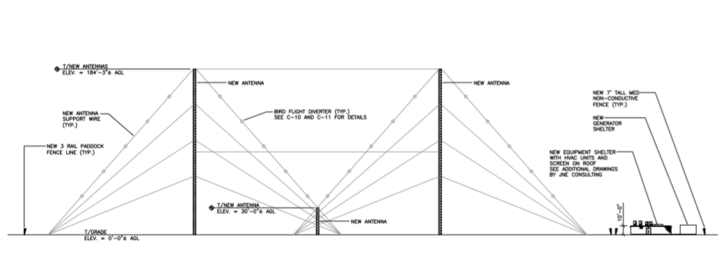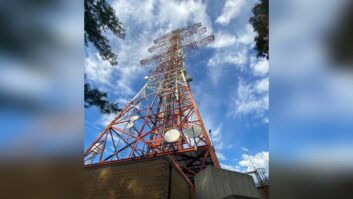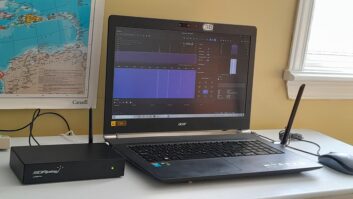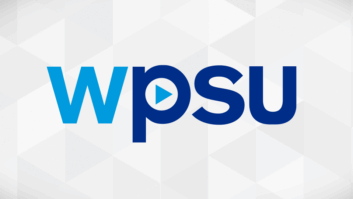
There’s a plan in the works to build a new international shortwave radio station in Illinois, one that would use the Digital Radio Mondiale modulation system. But now several prominent members of the U.S. shortwave community are asking the Federal Communications Commission to take a closer look first.
Parable Broadcasting Co. in April asked the FCC to allow it to build the station in Batavia, Ill., west of Chicago, using the call sign WPBC. It wants to offer “broadcasting and data services.”
Specifically, Parable wrote that the station would “serve the areas of Europe that may be authorized by the commission. The planned broadcast content includes religious and educational programming, as well as data content provided by third parties.” It added that it wants to “take advantage of the recent push by the National Association of Shortwave Broadcasters to develop and provide content for the growing DRM market.”
Now three individuals, collectively called the High-Frequency Parties, filed an informal objection. It’s that wording about data content that concerns them.
Bennett Z. Kobb, Kim Andrew Elliott and Christopher D. Rumbaugh said international broadcast stations in the U.S. are intended “to be received directly by the general public in foreign countries.”
Now they told the FCC that it is impossible to tell from the Parable application whether all of the data services and data provided by third parties will qualify.
Elliott is a former VOA employee who produces the program “Shortwave Radiogram” and is active on Twitter. Rumbaugh publishes the DRMNA.info website. Kobb has held various roles in radio and telecommunications including launching a telecom newsletter and writing books about spectrum allocations. He currently is a government contractor. The three have filed joint comments to the FCC before.
They wrote to the commission: “Various elements of the application and its geographical location suggest that the station will be engaged in the provision of point-to-point data services for hire, a common carrier or private carrier of messages not ‘intended for direct reception by the general public’ and not ‘to be received directly by the general public in foreign countries.’”
Nothing in the rules allows non-broadcast service, including ancillary or auxiliary services, they continued. “The applicant proposes to use the Digital Radio Mondiale (DRM) standard. All data messages from this station must be in a form readily decoded by ordinary DRM receivers and rendered as publicly accessible content without encryption or obscuration of their purpose or meaning. While Section §73.758 authorizes ‘datacasting’ to stations using DRM, it does not allow any form of datacasting that is not also broadcasting.”
[Related: “U.S. Shortwave Broadcasters Eye Digital”]
They said they’re definitely not against international data broadcasts or to DRM. (“Our members pioneered such services at the Voice of America and have operated DRM promotional websites recognized by the DRM Consortium for more than a decade.”) But they said someone wishing to conduct commercial HF point-to-point messaging for third parties should do so in a service dedicated to that function; if none exists they should petition the FCC for one.
While the FCC has authorized international data stations experimentally, those were “never conceived to engage in revenue operations indefinitely as an alternative to regular spectrum allocations and transparent, public license assignment procedures.”
In a separate email to Radio World, Kobb noted recent news coverage of shortwave applications for private data communication services such as instant stock trading; examples are here and here. Kobb emphasized that the objectors have no reason to think Parable is associated with those particular projects.
But regardless of audio programs that Parable may transmit, the three told the FCC that licensing a point-to-point message facility this way would be “an impermissible excursion around formalizing an international private data service or updating existing rules to accommodate it.” So they say the commission FCC should require Parable to certify that “no nonpublic, non-broadcast, nondisclosed, encrypted, confidential or clandestine data messages shall be sent over the proposed station.”
They added that the FCC needs to update its “hoary Part 73F rules, some dating from the 1930s and now without any articulable public interest basis.” These include “excessive” minimum required power level and a prohibition on domestic service. “Rule changes might embrace data communications under an expanded scope of service.”
Radio World invited comment from Parable via its attorney, Donna Balaguer of Fish & Richardson P.C. She replied in an email: “We have just received the informal objection and require time to review it. However, Parable Broadcasting Company proposes to provide valuable cultural and educational content overseas, as intended by the FCC for International Broadcast Stations. Parable’s application complies with FCC rules in all aspects.”
The application lists a Virginia address for the company and lists Stephen J. Bartlett as president. Its consulting engineer is Stephen Lockwood of Hatfield & Dawson Consulting Engineers, whose engineering work can be seen in the application. [Read the Parable application including technical filing.]
Parable’s facility would operate on the 5.9–15.8 MHz international shortwave bands with 15 kW power. Two 10 kW Amplifier Systems transmitters (main and standby) would feed 550 feet of 5-inch Comscope pressurized coax to a “super high gain” TCI log-periodic antenna system. The latter would consist of three towers, including two at 184 feet, with antenna power gain of 18.0 dBi, which the application notes is “a multiplier of 63.1.”







